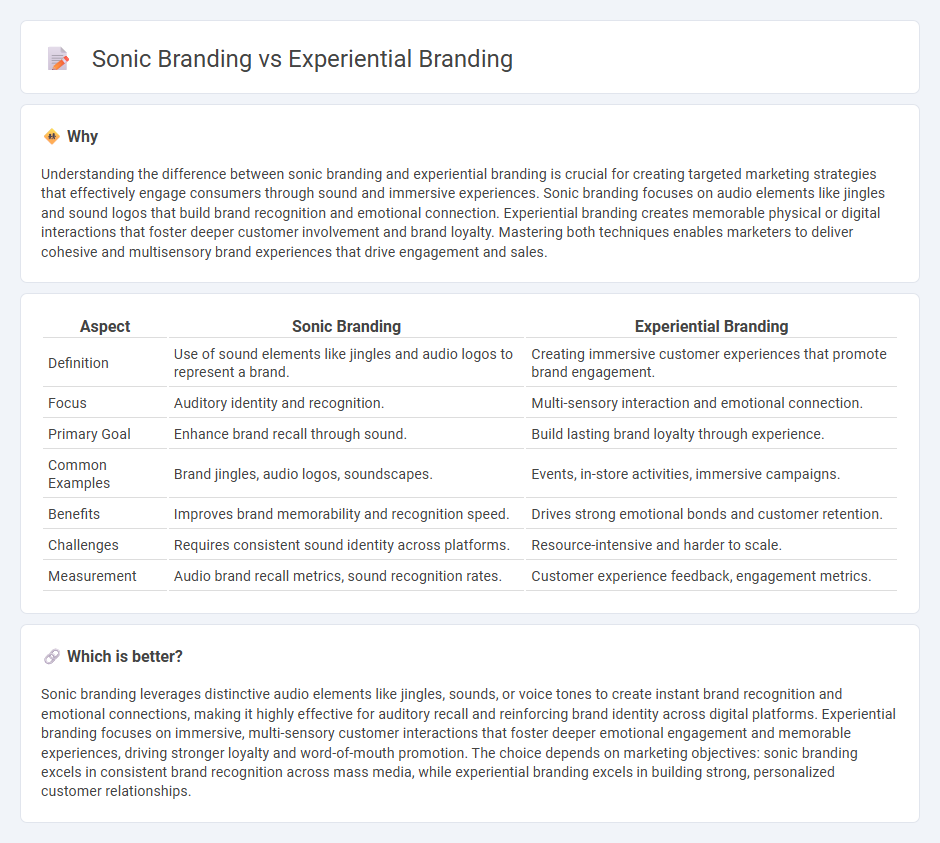
Sonic branding uses distinctive audio elements like jingles, sound logos, and voice tones to create memorable brand identities that resonate emotionally with consumers. Experiential branding focuses on immersive, multi-sensory experiences that engage customers directly through events, environments, or interactive touchpoints, forging deeper emotional connections and brand loyalty. Explore the unique advantages and strategic applications of sonic branding and experiential branding to elevate your marketing efforts.
Why it is important
Understanding the difference between sonic branding and experiential branding is crucial for creating targeted marketing strategies that effectively engage consumers through sound and immersive experiences. Sonic branding focuses on audio elements like jingles and sound logos that build brand recognition and emotional connection. Experiential branding creates memorable physical or digital interactions that foster deeper customer involvement and brand loyalty. Mastering both techniques enables marketers to deliver cohesive and multisensory brand experiences that drive engagement and sales.
Comparison Table
| Aspect | Sonic Branding | Experiential Branding |
|---|---|---|
| Definition | Use of sound elements like jingles and audio logos to represent a brand. | Creating immersive customer experiences that promote brand engagement. |
| Focus | Auditory identity and recognition. | Multi-sensory interaction and emotional connection. |
| Primary Goal | Enhance brand recall through sound. | Build lasting brand loyalty through experience. |
| Common Examples | Brand jingles, audio logos, soundscapes. | Events, in-store activities, immersive campaigns. |
| Benefits | Improves brand memorability and recognition speed. | Drives strong emotional bonds and customer retention. |
| Challenges | Requires consistent sound identity across platforms. | Resource-intensive and harder to scale. |
| Measurement | Audio brand recall metrics, sound recognition rates. | Customer experience feedback, engagement metrics. |
Which is better?
Sonic branding leverages distinctive audio elements like jingles, sounds, or voice tones to create instant brand recognition and emotional connections, making it highly effective for auditory recall and reinforcing brand identity across digital platforms. Experiential branding focuses on immersive, multi-sensory customer interactions that foster deeper emotional engagement and memorable experiences, driving stronger loyalty and word-of-mouth promotion. The choice depends on marketing objectives: sonic branding excels in consistent brand recognition across mass media, while experiential branding excels in building strong, personalized customer relationships.
Connection
Sonic branding enhances experiential branding by creating memorable audio cues that deepen emotional connections and reinforce brand identity during customer interactions. Integrating consistent sound elements into experiential campaigns amplifies sensory engagement, making brand experiences more immersive and impactful. This synergy boosts brand recall and fosters a stronger, multi-sensory relationship with the audience.
Key Terms
**Experiential Branding:**
Experiential branding immerses customers in interactive and memorable brand experiences, engaging multiple senses to foster emotional connections and brand loyalty. It leverages events, environments, and hands-on activities to create meaningful interactions that go beyond traditional advertising. Discover how experiential branding transforms customer engagement and builds lasting brand identity.
Brand Experience
Experiential branding creates immersive, multisensory interactions that deeply engage consumers, while sonic branding focuses specifically on auditory elements to evoke emotional connections and reinforce brand identity. Both strategies enhance brand experience by fostering memorable and distinctive perceptions through tailored sensory stimuli. Explore how integrating experiential and sonic branding can amplify your brand's presence and customer loyalty.
Customer Engagement
Experiential branding creates immersive, multi-sensory interactions that deeply engage customers by evoking emotions and memories tied to a brand's identity. Sonic branding leverages sound elements like jingles, voiceovers, and audio logos to enhance brand recall and forge a unique auditory connection with consumers. Discover how aligning both strategies can amplify customer engagement and boost brand loyalty.
Source and External Links
What is Experiential Branding? - Experiential branding is a marketing strategy that creates emotional, authentic, immersive, and interactive experiences to forge deeper, personal connections between a brand and its audience by engaging them through storytelling and active participation.
What is experiential marketing? Key strategies to transform ... - Experiential marketing involves immersive, interactive, and personalized activities that build emotional connections and engage consumers actively to foster loyalty and memorable brand experiences.
Experiential Marketing: How To Create Immersive Brand ... - Experiential marketing invites consumers to participate in memorable, immersive events and activations that create authentic emotional ties and stand apart from traditional advertising by focusing on long-term brand loyalty over direct sales metrics.
 dowidth.com
dowidth.com